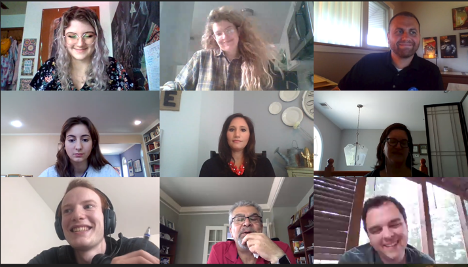
Michael Shumate, a graduate student in the Department of Mathematical Sciences in the Fulbright College of Arts and Sciences, successfully completed NASA's SCaN Intern Project while making the switch to a virtual work environment this summer.
"I have always really enjoyed everything NASA does," Shumate said.
Shumate's project, "Constructing Orbital Simulations for Network Analysis," focused on problems seen in orbital networks that do not appear in networks on Earth's surfaces.
 "Unlike an Earth network, where you can pick up your cell phone and call whoever you want at any time, space networks require much greater involvement," Shumate said.
"Unlike an Earth network, where you can pick up your cell phone and call whoever you want at any time, space networks require much greater involvement," Shumate said.
"With a space network, the path can be lost — you can have the Earth in between the path, and there's also the huge distance," he said. "Say you have a network on Mars and want to connect it from Earth. There's an 11-something-minute delay in connection time."
Using topological data analysis to understand different mathematical structures relative to orbital networks, Shumate and his fellow interns hope to better understand why these problems exist and find a possible solution to the problem, Shumate said.
The internship, hosted by NASA Glenn Research Center in Cleveland, Ohio, and NASA Goddard Space Flight Center in Greenbelt, Maryland, is open to students 16 or older who are pursuing a career in space communications and navigation, or have an interest in these areas.
Students are introduced to space communications and navigation knowledge and practices through their participation in the program.
Participants have the opportunity to perform hands-on training with real mission scenarios; gain exposure and analyze powerful space communication systems; utilize networks software tools; and effectively communicate their findings in a final presentation to NASA management.
As part of their internship, each student is paired with an experienced and multidisciplinary mentor who counsels the student with his/her work, and also engages with career planning.
To learn more about the SCaN Internship Project, visit their webpage.
About the Fulbright College of Arts and Sciences: The Fulbright College of Arts and Sciences is the largest and most academically diverse unit on campus with three schools, 16 departments and 43 academic programs and research centers. The college provides the majority of the core curriculum for all University of Arkansas students.
About the Graduate School and International Education: The Graduate School was founded in 1927 to assist the University of Arkansas in research, teaching, training and service. The Graduate School offers more than 130 degree programs leading to masters and doctoral degrees. The school also facilitates intercultural and international experiences to increase global competencies for the university and assists in the development of international, interdisciplinary and graduate programs. In the fall semester, the school has more students than ever before, with 4,354 graduate students working through research and rigorous study to build a better world.
Topics
Contacts
Olivia Kays, communications project manager
Fulbright College of Arts and Sciences
479-575-2130, okays@uark.edu
Amy Unruh, director of communications
Graduate School and International Education
479-575-5809, unruh@uark.edu